外研版九年级英语上册课件 Module 5 Unit 2 (共38张PPT)
文档属性
| 名称 | 外研版九年级英语上册课件 Module 5 Unit 2 (共38张PPT) | 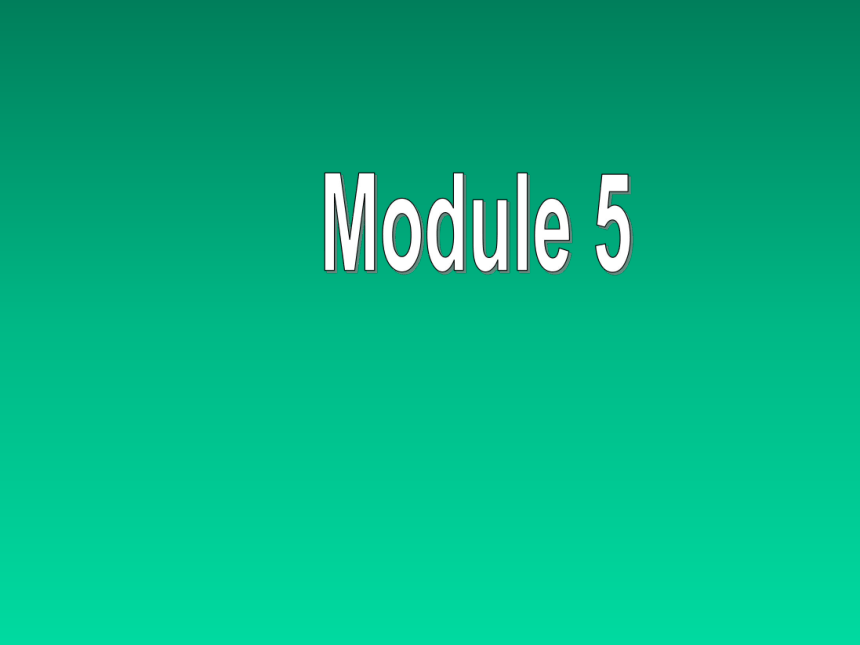 | |
| 格式 | ppt | ||
| 文件大小 | 5.4MB | ||
| 资源类型 | 教案 | ||
| 版本资源 | 外研版 | ||
| 科目 | 英语 | ||
| 更新时间 | 2022-08-07 08:42:14 | ||
图片预览

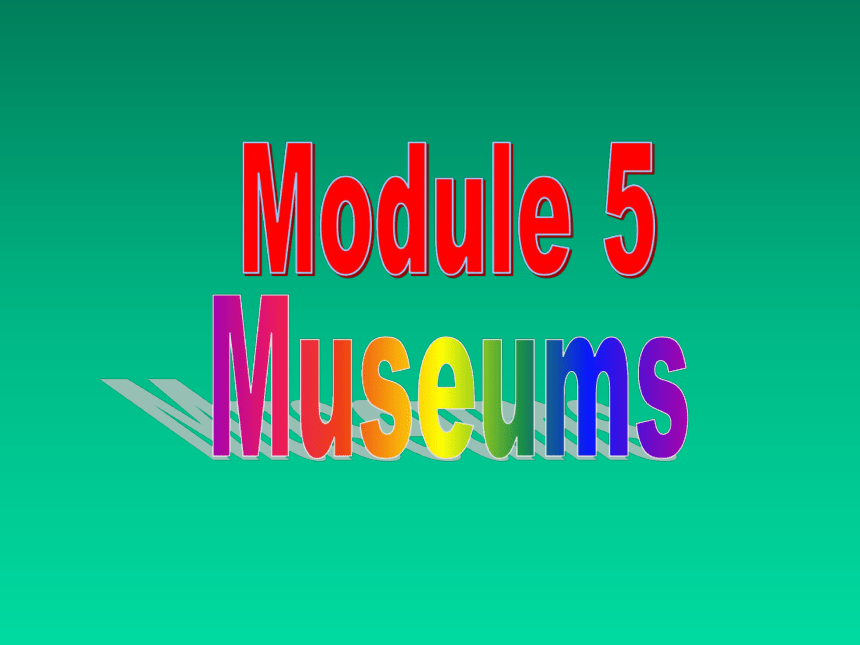
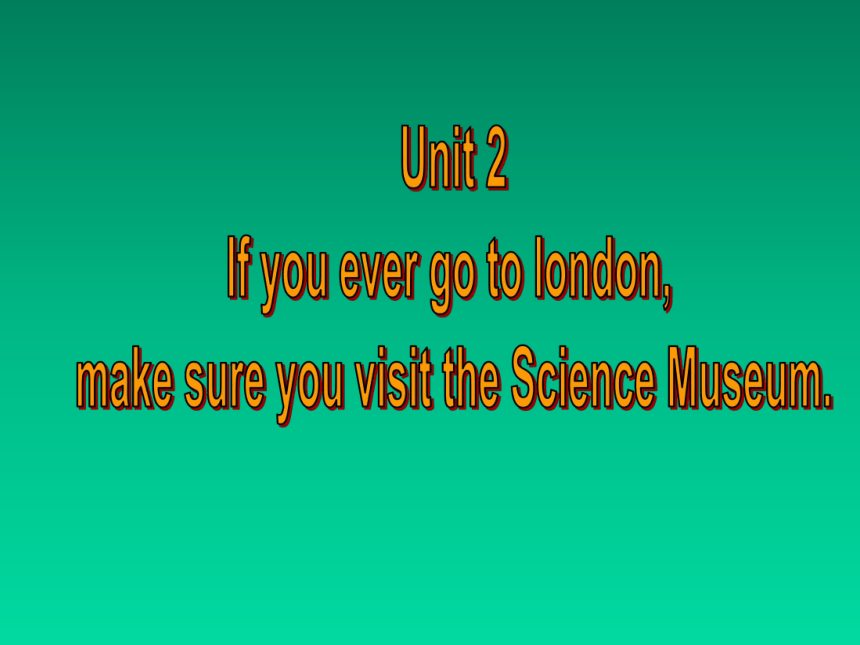
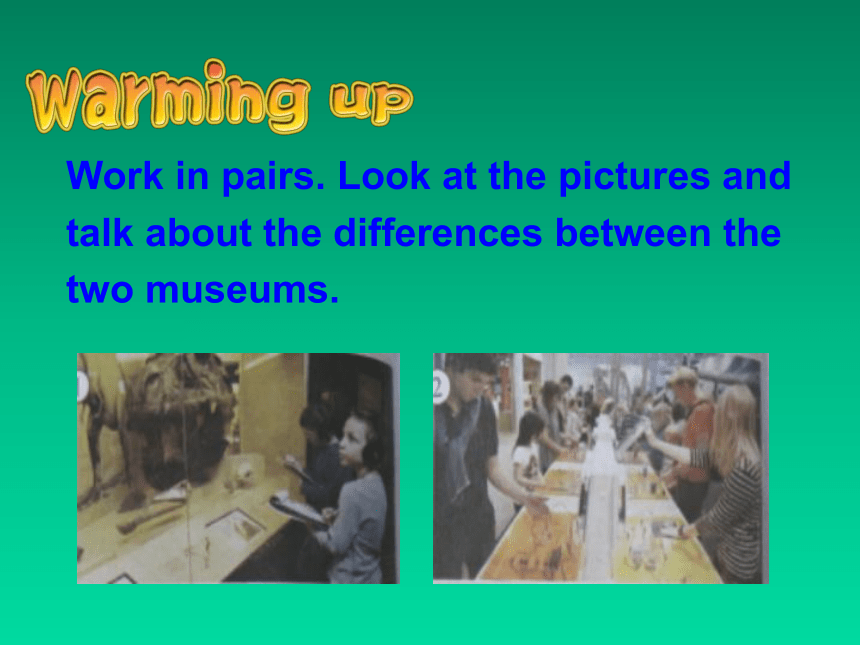
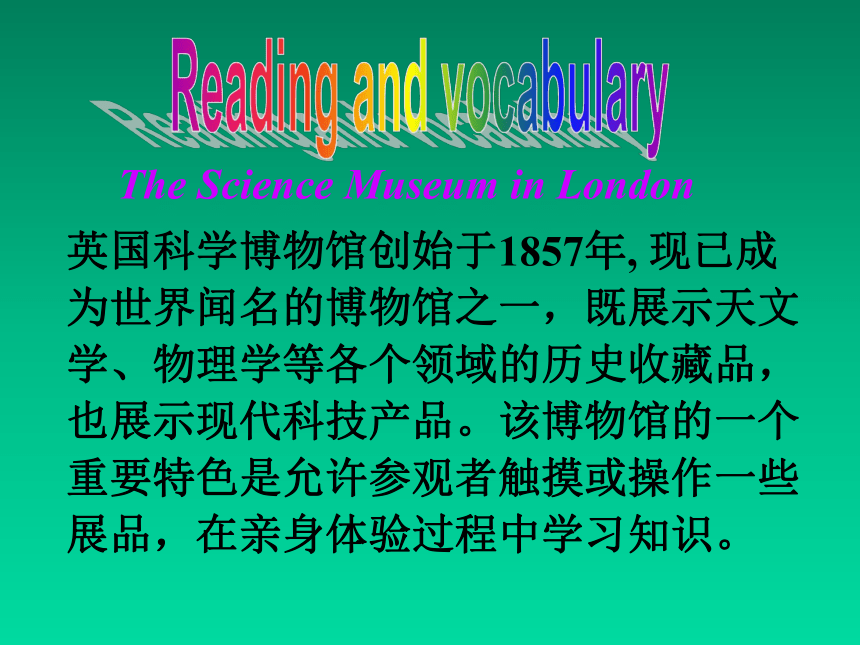

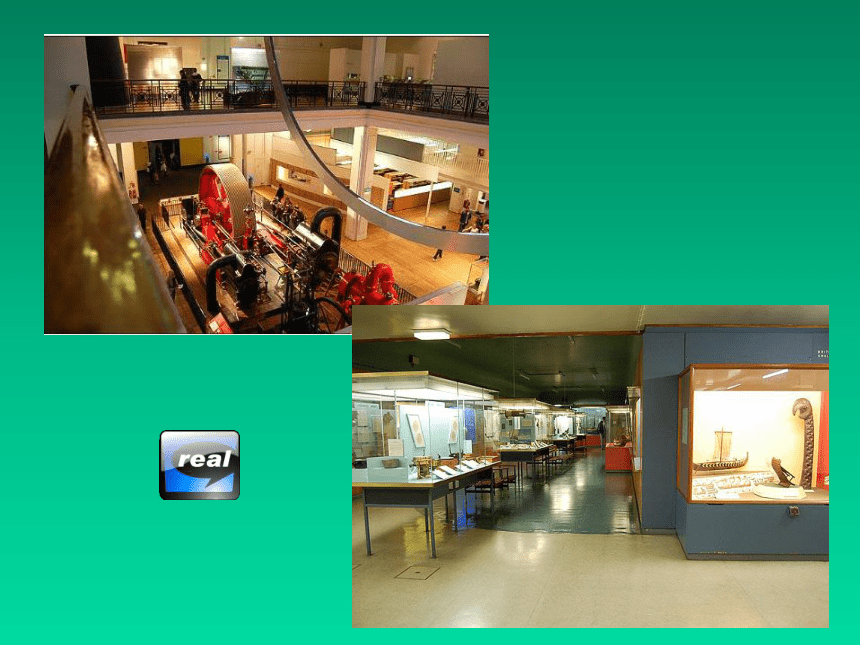
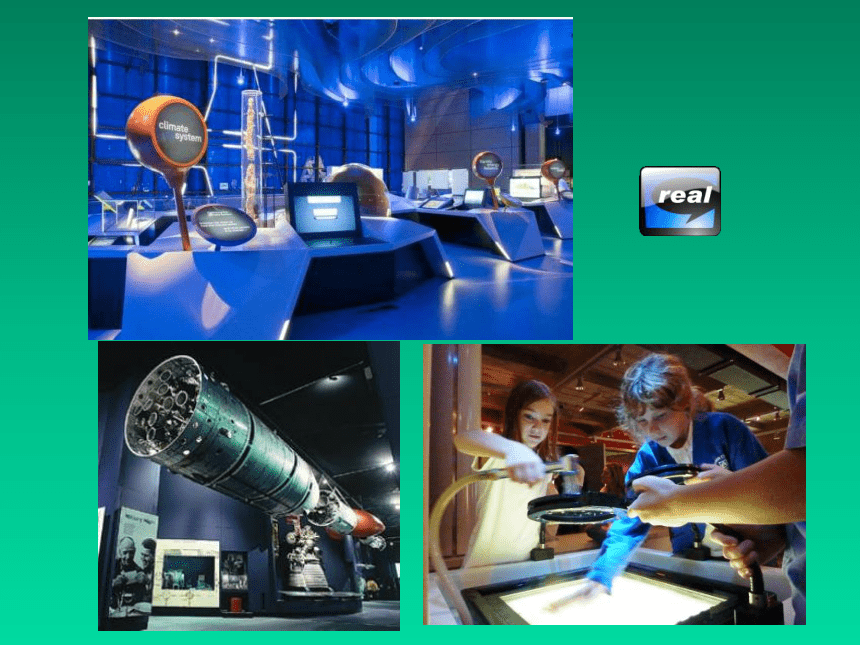
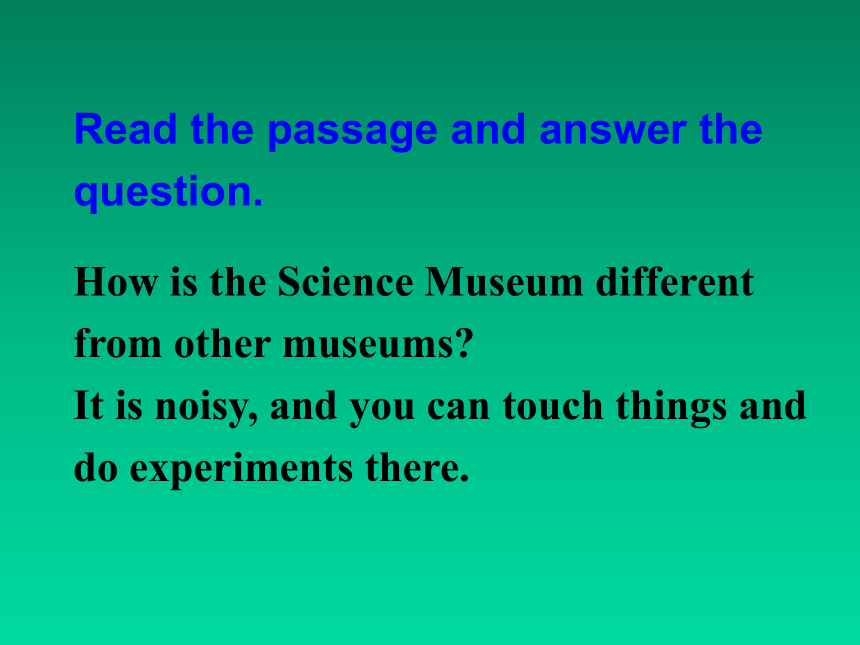

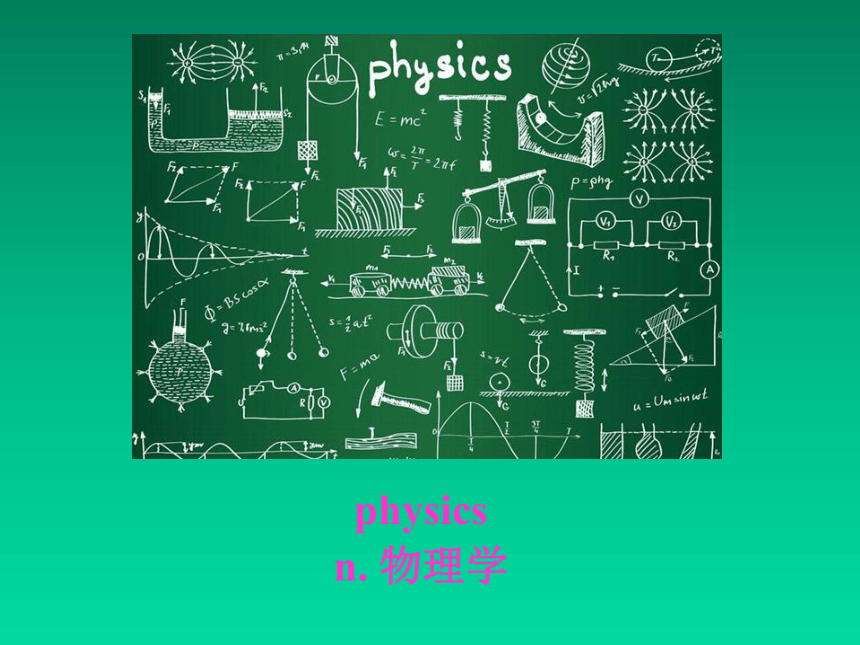
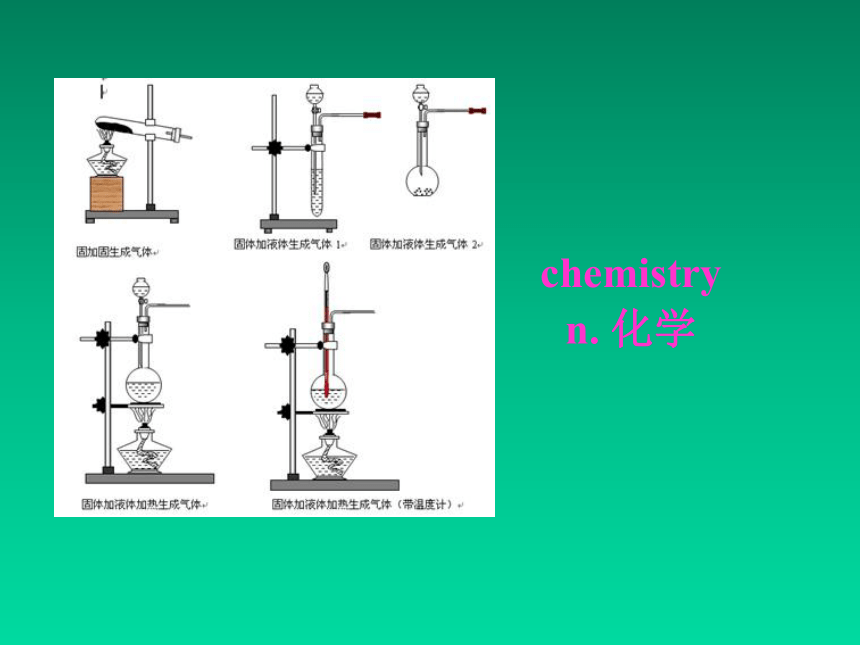
文档简介
(共38张PPT)
Work in pairs. Look at the pictures and talk about the differences between the two museums.
The Science Museum in London
英国科学博物馆创始于1857年, 现已成为世界闻名的博物馆之一,既展示天文学、物理学等各个领域的历史收藏品,也展示现代科技产品。该博物馆的一个重要特色是允许参观者触摸或操作一些展品,在亲身体验过程中学习知识。
How is the Science Museum different from other museums
It is noisy, and you can touch things and do experiments there.
Read the passage and answer the
question.
communications
n. (复数)通讯
physics
n. 物理学
chemistry
n. 化学
dig
v. 挖掘; 掘(洞)
coal n. 煤
X-ray
n. X射线; X光
experiment
n. 实验
sand
n. 沙; 沙子
truck
n.卡车; 货车
wheel
n. 轮子; 车轮
Complete the Tony’s favourite
museum column in the table.
Tony’s favourite museum Your favourite museum
Name
Place
the Science Museum
London
Tony’s favourite museum Your favourite museum
Favourite room
Opening hours
Price
the Launchpad
From 10am
to 6 pm
Free
Answer the questions. Use the
words in the box to help you.
chemistry communications control environment experiment physics X-ray
What can you learn about in the rooms on the second and third floors
We can learn about communications and the environment as well as maths, physics and chemistry.
2. What allows you to see inside your body
X-rays allow you to see inside your body.
3. What can you do in the Launchpad
You can do physics experiments and find out how people travel into space and back again.
4. What can you learn about on the fourth
and fifth floors
You can learn about medicine in the past.
1. … if you want to fill a bag with sand,
you have to control a kind of truck on
wheels and move it into the correct
place. …
如果你想将袋子装满沙子, 你得操控一
种带轮子的运输车, 并把车移动到正确的
位置。
fill … with…表示“用……装满……”。
e.g. The teacher filled a bottle with water.
老师在瓶子里注满了水。
control v. 操作; 操纵
e.g. You can control the machine.
你可以操纵那台机器。
2. If you compare the medicine of the past 、
with the medicine of today…
如果你比较一下过去的药物与现在的
药物……
compare… with…表示“拿……和……
作比较”。
e.g. Mr. Wu likes to compare Class Three
with Class Five.
吴老师喜欢拿三班和五班作比较。
3. The Science Museum is interesting for
people of all ages.
科学博物馆非常有趣, 可以说老少皆
宜。
of all ages 所有年龄段的
e.g. People of all ages visit the museum.
男女老少都来参观这个博物馆。
4. It is my favourite museum in the whole
world!
它是全世界我最喜欢的博物馆!
all和whole都可用作形容词, 意为“整个的; 全部的”,但在句中的位置不同。all通常位于定冠词、指示代词及物主代词之前; whole通常位于定冠词、指示代词及物主代词之后 。
e.g. All the family / The whole family
enjoy taking vacations.
所有家庭都喜欢度假。
I’m very busy all this week / this
whole week.
我整周都很忙。
But the Science Museum is
different … It is noisy!
__________________
the Science Museum
Decide what the underlined words
in the sentences refer to.
2. People talk about what they can see
and do here.
_______
_____________________
3. You can always find something new
and have a wonderful time there.
_____________________
people
in the Science Museum
in the Science Museum
When you write, you can use pronouns such as it, he, her, this, there… to avoid repetition. But remember to check whether the reference is clear or not.
There are a lot of museums in London, and one of the most popular is the British Museum. Thousands of people visit (1)____ every year. (2)_______ they can see lots of interesting things from different times and places.
it
There
Complete the passage with it, they
and there.
The British Museum is very traditional. Visitors must not make a noise, and (3)_____ must not touch anything or take photos. Entry to the museum is free, so people can visit (4)____ as often as they like.
they
it
根据所给提示将下列汉语句子翻译成英
语。
1. 放风筝在所有年龄段的人中都受欢
迎。(of all ages)
Flying kites is popular among people of all ages.
2. 我想用书装满箱子。(fill ... with ...)
I want to fill the box with books.
3. 他们仔细地比较了第一张地图和第二张地图。(compare ... with ...)
They compared the first map with the second one carefully.
4. 你能查清楚会议什么时候开始吗?(find out)
Can you find out when the meeting
will start
5. 她会唱歌,也会跳舞。(as well as)
She can dance as well as sing.
Complete the Your favourite museum column in the table in Activity 3.
Write a passage. Use the table and Activities 2 and 6 to help you. Say:
Write a passage about your
favourite museum. Pay attention
to the words it, they and there.
1. Are there many museums in your
town
2. Which one is your favourite
3. What is special about the museum
4. What can you see or do there
Work in pairs. Look at the pictures and talk about the differences between the two museums.
The Science Museum in London
英国科学博物馆创始于1857年, 现已成为世界闻名的博物馆之一,既展示天文学、物理学等各个领域的历史收藏品,也展示现代科技产品。该博物馆的一个重要特色是允许参观者触摸或操作一些展品,在亲身体验过程中学习知识。
How is the Science Museum different from other museums
It is noisy, and you can touch things and do experiments there.
Read the passage and answer the
question.
communications
n. (复数)通讯
physics
n. 物理学
chemistry
n. 化学
dig
v. 挖掘; 掘(洞)
coal n. 煤
X-ray
n. X射线; X光
experiment
n. 实验
sand
n. 沙; 沙子
truck
n.卡车; 货车
wheel
n. 轮子; 车轮
Complete the Tony’s favourite
museum column in the table.
Tony’s favourite museum Your favourite museum
Name
Place
the Science Museum
London
Tony’s favourite museum Your favourite museum
Favourite room
Opening hours
Price
the Launchpad
From 10am
to 6 pm
Free
Answer the questions. Use the
words in the box to help you.
chemistry communications control environment experiment physics X-ray
What can you learn about in the rooms on the second and third floors
We can learn about communications and the environment as well as maths, physics and chemistry.
2. What allows you to see inside your body
X-rays allow you to see inside your body.
3. What can you do in the Launchpad
You can do physics experiments and find out how people travel into space and back again.
4. What can you learn about on the fourth
and fifth floors
You can learn about medicine in the past.
1. … if you want to fill a bag with sand,
you have to control a kind of truck on
wheels and move it into the correct
place. …
如果你想将袋子装满沙子, 你得操控一
种带轮子的运输车, 并把车移动到正确的
位置。
fill … with…表示“用……装满……”。
e.g. The teacher filled a bottle with water.
老师在瓶子里注满了水。
control v. 操作; 操纵
e.g. You can control the machine.
你可以操纵那台机器。
2. If you compare the medicine of the past 、
with the medicine of today…
如果你比较一下过去的药物与现在的
药物……
compare… with…表示“拿……和……
作比较”。
e.g. Mr. Wu likes to compare Class Three
with Class Five.
吴老师喜欢拿三班和五班作比较。
3. The Science Museum is interesting for
people of all ages.
科学博物馆非常有趣, 可以说老少皆
宜。
of all ages 所有年龄段的
e.g. People of all ages visit the museum.
男女老少都来参观这个博物馆。
4. It is my favourite museum in the whole
world!
它是全世界我最喜欢的博物馆!
all和whole都可用作形容词, 意为“整个的; 全部的”,但在句中的位置不同。all通常位于定冠词、指示代词及物主代词之前; whole通常位于定冠词、指示代词及物主代词之后 。
e.g. All the family / The whole family
enjoy taking vacations.
所有家庭都喜欢度假。
I’m very busy all this week / this
whole week.
我整周都很忙。
But the Science Museum is
different … It is noisy!
__________________
the Science Museum
Decide what the underlined words
in the sentences refer to.
2. People talk about what they can see
and do here.
_______
_____________________
3. You can always find something new
and have a wonderful time there.
_____________________
people
in the Science Museum
in the Science Museum
When you write, you can use pronouns such as it, he, her, this, there… to avoid repetition. But remember to check whether the reference is clear or not.
There are a lot of museums in London, and one of the most popular is the British Museum. Thousands of people visit (1)____ every year. (2)_______ they can see lots of interesting things from different times and places.
it
There
Complete the passage with it, they
and there.
The British Museum is very traditional. Visitors must not make a noise, and (3)_____ must not touch anything or take photos. Entry to the museum is free, so people can visit (4)____ as often as they like.
they
it
根据所给提示将下列汉语句子翻译成英
语。
1. 放风筝在所有年龄段的人中都受欢
迎。(of all ages)
Flying kites is popular among people of all ages.
2. 我想用书装满箱子。(fill ... with ...)
I want to fill the box with books.
3. 他们仔细地比较了第一张地图和第二张地图。(compare ... with ...)
They compared the first map with the second one carefully.
4. 你能查清楚会议什么时候开始吗?(find out)
Can you find out when the meeting
will start
5. 她会唱歌,也会跳舞。(as well as)
She can dance as well as sing.
Complete the Your favourite museum column in the table in Activity 3.
Write a passage. Use the table and Activities 2 and 6 to help you. Say:
Write a passage about your
favourite museum. Pay attention
to the words it, they and there.
1. Are there many museums in your
town
2. Which one is your favourite
3. What is special about the museum
4. What can you see or do there
同课章节目录
- Module 1 Wonders of the world
- Unit 1 It's more than 2,000 years old.
- Unit 2 The Grand Canyon was not just big.
- Unit 3 Language in use
- Module 2 Public holidays
- Unit 1 My family always go somewhere interesting a
- Unit 2 We have celebrated the festival since the f
- Unit 3 Language in use
- Module 3 Heroes
- Unit 1 She trained hard,so she became a great play
- Unit 2There were few doctors, so he had to work ve
- Unit 3 Language in use
- Module 4 Home alone
- Unit 1 I can look after myself, although it won’t
- Unit 2 I became so bored with their orders that I
- Unit 3 Language in use
- Module 5 Museums
- Unit 1 Don't cross that rope!
- Unit 2 If you ever go to London, make sure you vis
- Unit 3 Language in use
- Module 6 Problems
- Unit 1 If I start after dinner, I'll finish it be
- Unit 2 If you tell him the truth now, you will sho
- Unit 3 Language in use
- Revision Module A
- Module 7 Great books
- Unit 1 We're still influenced by Confucius's idea
- Unit 2 It is still read and loved.
- Unit 3 Language in use
- Module 8 Sports life
- Unit 1 Daming wasn't chosen for the team last time
- Unit 2 He was invited to competitions around the w
- Unit 3 Language in use
- Module 9 Great inventions
- Unit 1 Will computers be used more than books in t
- Unit 2 Will books be replaced by the Internet?
- Unit 3 Language in use
- Module 10 Australia
- Unit 1 I have some photos that I took in Australia
- Unit 2 The game that they like most is Australian
- Unit 3 Language in use
- Module 11 Photos
- Unit 1 He's the boy who won the photo competition
- Unit 2 The photo which we liked best was taken by
- Unit 3 Language in use
- Module 12 Save our world
- Unit 1 If everyone starts to do something, the wor
- Unit 2 Repeat these three words daily: reduce, reu
- Unit 3 Language in use
- Revision Module B
